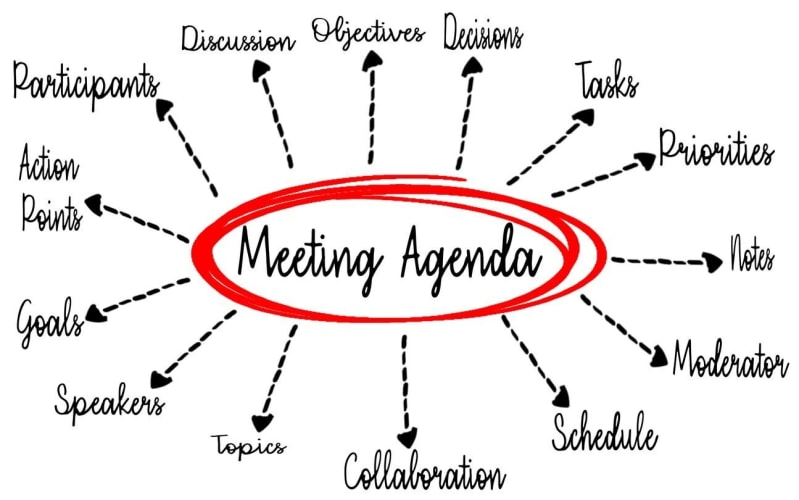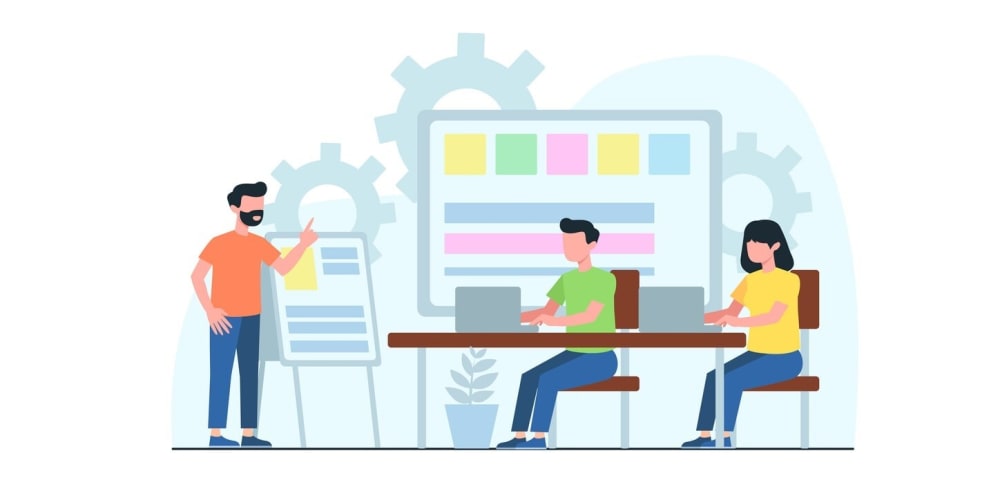Need a simple yet effective meeting agenda format? A well-structured agenda keeps meetings focused and efficient. In this guide, you’ll explore practical templates and tips to create agendas that enhance productivity and keep your team on track.
Key Takeaways
- A well-structured meeting agenda is essential for maintaining focus, enhancing productivity, and ensuring that all important topics are covered during meetings.
- Key components of an effective meeting agenda include clearly defined objectives, prioritized discussion topics, and allocated time for each item to ensure efficient time management.
- Utilizing meeting agenda templates can help in organizing discussions and maintaining participant engagement, while avoiding common mistakes such as agenda overload and lack of clarity.
What is a meeting agenda format?

A meeting agenda is more than just a list of topics; it is a structured roadmap that guides the flow of the meeting. It serves to keep the discussion focused on the meeting’s purpose and ensures that all important points are covered. A well-defined agenda makes meetings more efficient and allows participants to prepare adequately, resulting in more productive gatherings.
The purpose of using a central tool for meeting agendas is to reduce workload, connect to the meeting’s purpose, and enhance productivity. A structured meeting agenda typically includes the meeting goal, a list of topics, time allocations for each topic, and assigned facilitators. This structure helps in managing time effectively and keeps the meeting on track, avoiding any wastage of time.
An effective meeting agenda maximizes productivity, keeps the team focused, and enhances participant engagement and clarity of discussion. It ensures attendees feel valued and their contributions align with the meeting’s objectives. A well-structured agenda can significantly enhance team engagement and productivity during meetings, making it an indispensable tool for any successful team.
Key components of a meeting agenda

Creating a meeting agenda involves identifying and including several key components that ensure the meeting is productive and focused. These components are:
- Objectives
- Topics
- Time allocations
Each of these elements plays a crucial role in guiding the meeting and ensuring all important discussion points are covered.
Objectives help guide the purpose of the meeting and set clear expectations for attendees. Topics categorize the discussion items into informational, discussion, and action items, prioritizing them by their importance. Time allocations ensure effective time management and keep the meeting on track, providing an objective framework for the discussion.
Each of these components is explored in more detail below.
Objectives
Clear objectives are the cornerstone of a productive meeting agenda. They guide the discussion and ensure focus during the meeting. Communicating the meeting’s objectives in the agenda sets clear expectations and helps attendees prepare adequately. This preparation prevents misunderstandings and keeps discussions productive.
When defining a meeting’s objectives, consider the purpose, expected outcomes, and alignment with overall goals. Specific objectives help participants understand their contributions and keep discussions on track. For instance, specifying actionable goals in agenda items is crucial to prevent unproductive meetings.
Meetings without a clear agenda often result in aimless discussions, hindering productivity. Therefore, defining specific objectives not only enhances the meeting’s effectiveness but also ensures that all attendees feel valued and understand their roles in achieving the desired outcomes.
Topics
Identifying and prioritizing topics is essential for a focused meeting agenda. Main topics should be framed as questions to promote engagement and keep the conversation centered on relevant issues. Categorize agenda items into informational, discussion topics, and action items. This categorization helps in organizing the meeting flow and ensuring that all important points are covered. Additionally, it is crucial to identify the key areas that need attention.
Key guidelines for arranging topics in an agenda:
- Arrange topics by importance to ensure critical issues are addressed first.
- Place time-sensitive topics at the beginning of the agenda to ensure they are addressed before key participants leave.
- Avoid ambiguity in agenda items to prevent confusion and misalignment among participants.
For example, in a team meeting agenda, you might categorize items as status updates, discussion topics, and action items. This structure helps keep everyone on the same page and ensures that important points are not overlooked.
Time allocations
Allocating time for agenda items is vital for effective time management. It ensures that each topic gets the attention it deserves and keeps the meeting on track. When estimating time allocations, consider including time for:
- Introductions
- Discussions
- Decision-making
- Possible tech issues
Time allocations should be based on the complexity and importance of each topic. Be realistic with your estimated time and factor in extra time for unforeseen conversations. A good rule of thumb is to plan for 20% more time than anticipated for each topic.
Using a meeting agenda template that includes an allotted time column for each topic can help manage the team’s time effectively. This approach ensures that discussions are thorough and not rushed, leading to more productive meetings.
How to create a meeting agenda format

Creating a meeting agenda is essential for a successful meeting. It helps to maintain focus and productivity throughout the discussion. An effective meeting agenda serves as a roadmap for participants, outlining the sequence of topics, leaders for each item, and the time allocated. Failing to create an agenda can lead to meetings lacking focus and productivity.
The process of creating a meeting agenda involves several key steps: defining the meeting’s purpose, gathering input from participants, and assigning roles and responsibilities. Each of these steps contributes to a comprehensive and effective agenda that ensures all important points are covered and that the meeting remains focused.
Define the meeting's purpose
The first step in creating a meeting agenda is defining the meeting’s purpose. A clearly stated meeting purpose aligns attendees’ contributions with desired outcomes. This alignment is crucial for ensuring that the meeting remains focused and productive.
Meetings often suffer from insufficient preparation, leading to vague agendas and wasted time. Clearly stating the meeting’s purpose provides a roadmap, guiding discussions toward desired outcomes and preventing aimless conversations.
Gather input from participants
Gathering input from participants ensures that all voices are heard and relevant topics are included in the meeting agenda. Involving team members in the agenda creation fosters a sense of ownership and boosts morale.
Encouraging participants to share their feedback, suggestions, and concerns before the meeting facilitates a better, open discussion. This approach ensures that the agenda is comprehensive and includes all important points that need to be addressed.
Assign roles and responsibilities
Assigning roles and responsibilities is crucial for ensuring focused and organized discussions. Designate leaders for each agenda item to keep discussions focused and organized. Defining roles before the meeting allows participants to prepare adequately for their contributions.
Accurate time estimation for each agenda item ensures thorough and unrushed discussions. This approach ensures that the meeting remains productive and that all important points are covered.
Meeting agenda templates

Meeting agenda templates are valuable tools for creating structured and effective agendas. Utilizing customizable templates can enhance the structure and clarity of meeting agendas. There are various free templates available for Word and Google Docs to assist in creating effective agendas.
These templates help outline priorities and important discussion points. With meeting agenda templates from Adobe Express, users can create, save, and share meeting agendas. Free meeting agenda templates can also be downloaded from the Microsoft Office template gallery.
These templates are designed to aid in keeping meetings organized and ensuring all participants are aware of the meeting minutes agenda.
Team meeting agenda template
A team meeting agenda should focus on collaboration and maintaining alignment among team members. This template helps ensure that all important points are covered and that the meeting remains productive.
A team meeting agenda template provides a clear structure for discussions, helping avoid unproductive meetings. It ensures that all team members are on the same page and that the meeting remains focused on the important discussion points.
Project kickoff meeting agenda template
The project kickoff meeting agenda template is designed to align project team members on project expectations and responsibilities from the start. This template includes timeboxed items, assigned teammates, and relevant files.
A project kickoff meeting agenda template ensures all team members understand their roles and responsibilities, leading to a more organized and productive meeting. It also helps avoid unproductive meetings by providing a clear structure for discussions.
Retrospective meeting agenda template
Retrospective meetings prioritize reflection on previous work to inform future improvements. A retrospective meeting agenda template helps ensure that all important points are covered and that the meeting remains productive.
A retrospective meeting agenda template provides a clear structure for discussions, helping avoid unproductive meetings. It ensures that all team members are on the same page and that the meeting remains focused on the important discussion points.
Tips for effective meeting agendas

Creating an effective meeting agenda involves more than just listing topics. A well-structured meeting agenda includes:
- Clear expectations and guiding conversation points
- Allocating specific time slots for each agenda item to promote adherence to the schedule and ensure all topics are covered
- Sharing the agenda in advance to allow for participant preparation and keep focus on priorities
Important practices for effective meetings include:
- Linking pre-reading materials
- Tracking notes and action items during the meeting
- Respecting time limits for agenda items to maintain focus and efficiency
This holistic approach to creating agendas ensures productive meetings and better engagement from participants.
Share the agenda in advance
Distributing the agenda early allows participants to prepare insights and questions, leading to more focused discussions and clear expectations. Failing to communicate the agenda in advance can hinder participants’ preparedness, resulting in unproductive meetings.
Sending the agenda at least an hour before the meeting allows time for questions or adjustments. Pre-reading materials can reduce initial questions, allowing for a more productive session.
Link pre-reading materials
Links to relevant pre-reading materials should be included before the meeting to prepare participants. This helps ensure everyone arrives prepared to contribute, preparing the meeting to be more efficient and focused, utilizing available resources.
Including links to essential documents helps reduce the need for lengthy explanations during the meeting.
Track notes and action items
Tracking notes during meetings is essential for accountability and establishing next steps. Clear note-taking ensures that vital information is captured and can be referenced later. The meeting agenda should be used during the meeting. This will help effectively track notes and action items.
After the meeting, the note taker is responsible for following up with meeting notes that include decisions, tasks, and unresolved questions. This follow-up ensures nothing important gets overlooked and all action items are addressed.
Examples of meeting agendas
To give you a practical understanding of how to structure your own agendas, here are some meeting agenda examples of different types of meeting agendas.
These examples illustrate how to organize discussions and ensure all relevant discussion item topics are covered to discuss efficient meetings that have been discussed.
One-on-one meeting agenda example
One-on-one meetings are scheduled conversations between two individuals. These situations can arise in different contexts. Examples include:
- Manager-employee relationships
- Client interactions
- Mentoring
- Peer-to-peer connections where individuals meet.
Remote one-on-one meetings prioritize building rapport. They also emphasize the importance of clear, conversation-focused communication.
Key points to include in one-on-one meetings should encompass checking in on well-being, current work assignments, and immediate concerns. A successful one-on-one meeting should prioritize discussions on growth and development rather than just status updates.
Daily scrum meeting agenda example
A daily scrum meeting is a gathering for the team. It is used to synchronize efforts, share progress, and plan for the day. The purpose of daily scrum meetings is to keep the team aligned during a sprint.
Topics typically covered in a daily scrum meeting include:
- Blockers
- A recap of previous work
- Goals for the day
- Progress towards sprint goals
These meetings typically last around 15 minutes and focus on key areas like progress and any obstacles team members are facing in their review for the next meeting date.
The advantage of daily scrum meetings is that they help maintain momentum and address issues promptly.
Leadership team meeting agenda example
Leadership meetings are designed to facilitate:
- High-level discussions and alignment across teams in an organization
- Strategic discussions focusing on long-term goals, performance metrics, and necessary adjustments to action plans
- Cross-departmental updates to gauge progress and address challenges faced by different teams, fostering collaboration among senior managers.
Leadership meetings often incorporate personal updates to strengthen team connections alongside strategic discussions, professional development, team building, and business team meetings.
Common mistakes to avoid
Even with the best intentions, creating a meeting agenda can go awry if certain common mistakes are not avoided. Overloading an agenda, lacking clarity, and ignoring time allocations are some of the pitfalls that can detract from meeting effectiveness.
Utilizing the agenda as a framework helps in documenting decisions and tracking action items effectively. Documenting next steps directly in the agenda can help ensure that nothing important gets overlooked.
Overloading the agenda
Having too many topics on the agenda can dilute focus and lead to rushed discussions. To avoid agenda overload, it’s essential to prioritize topics based on their urgency and importance.
The use of a structured agenda minimizes confusion and enhances the overall efficiency of the meeting. This approach ensures that all important points are covered without overwhelming the participants.
Lack of clarity
A well-crafted agenda:
- Sets the boundaries for discussions, helping to prevent off-topic conversations.
- Provides clear objectives that serve as a roadmap for meetings, guiding discussions toward desired outcomes.
- Allows for focused discussions and efficient use of time by having defined objectives and topics.
Clarity in meeting agendas leads to more productive meetings and better participant engagement.
Ignoring time allocations
Allocating specific times to each agenda item is essential for ensuring efficient time allocation. Time allocations help keep discussions on track, allowing for comprehensive coverage of all agenda items without overscheduling.
Ignoring allocated time for agenda items can result in overloaded meetings, leading to rushed discussions and unproductive outcomes. Adhering to time allocations is crucial for achieving meeting objectives and maintaining participant engagement.
Summary
In summary, a well-structured meeting agenda is a powerful tool that ensures productive and efficient meetings. By clearly defining objectives, identifying and prioritizing topics, and allocating time for each agenda item, you can keep your meetings focused and on track. Utilizing meeting agenda templates can further enhance the structure and clarity of your agendas, making it easier to organize discussions and ensure all important points are covered.
Remember to share the agenda in advance, link pre-reading materials, and track notes and action items during the meeting. These practices help ensure that all participants are prepared and that the meeting remains productive. Avoid common mistakes such as overloading the agenda, lacking clarity, and ignoring time allocations to maintain the effectiveness of your meetings.
By implementing these tips and using the provided templates and examples, you can transform your meetings into productive powerhouses. Start creating effective meeting agendas today and experience the difference they can make in your team’s productivity and engagement.
The purpose of a meeting agenda is to provide a structured roadmap that outlines the meeting's purpose, key discussion points, and time allocations, ensuring discussions remain productive and focused.
Meeting agenda templates are invaluable for structuring discussions and ensuring all critical points are addressed, thereby enhancing clarity. Additionally, they save time by offering a customizable framework for organizing meetings effectively.
A meeting agenda should include objectives, topics to be discussed, and time allocations for each item. These components are essential for driving the meeting effectively and covering all critical discussion points.
It is important to share the agenda in advance as it enables participants to prepare relevant insights and questions, fostering more focused discussions. This transparency ensures that everyone knows what to expect during the meeting.
To avoid overloading the meeting agenda, prioritize topics by their urgency and importance, and utilize a structured agenda to maintain clarity and efficiency. This approach helps keep discussions focused and productive.





